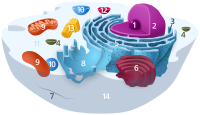
Photo from wikipedia
ER-phagy is a selective endoplasmic reticulum (ER) autophagy mediated by ER-localized receptors, which ensures proper cellular homeostasis under stress. However, it remains unclear whether ER-phagy is involved in skeletal muscle… Click to show full abstract
ER-phagy is a selective endoplasmic reticulum (ER) autophagy mediated by ER-localized receptors, which ensures proper cellular homeostasis under stress. However, it remains unclear whether ER-phagy is involved in skeletal muscle response to exercise stress. Male 8-week-old Sprague-Dawley rats were subjected to an exercise protocol comprising a 90-min downhill run with a slope of -16° and a speed of 16 m/min. The soleus of the rats was sampled at 0, 12, 24, 48, and 72 h after exercise. After exercise, the sarcoplasmic/ER calcium ATPase (SERCA) content decreased, the protein disulphide isomerase (PDI) content increased, and ER stress (GRP78 and CRT) and autophagy (FAM134B and LC3)-related protein expression increased in the soleus muscle of rats, and gradually recovered with time. We also used pharmacological methods to simulate the effects of exercise stress on skeletal muscle cells to further explore the mechanism of ER-phagy in skeletal muscle cells. Thapsigargin was used to inhibit the SERCA pump of L6 myoblasts and successfully induce ER stress and activate ER-phagy. During this process, the ER-phagy receptor FAM134B anchors and fragments ER, and then binds with LC3 to form autophagosomes. These results suggest that ER-phagy is involved in the skeletal muscle cell response to exercise stress, which helps to maintain cellular ER homeostasis during exercise.
Journal Title: General physiology and biophysics
Year Published: 2022
Link to full text (if available)
Share on Social Media: Sign Up to like & get
recommendations!